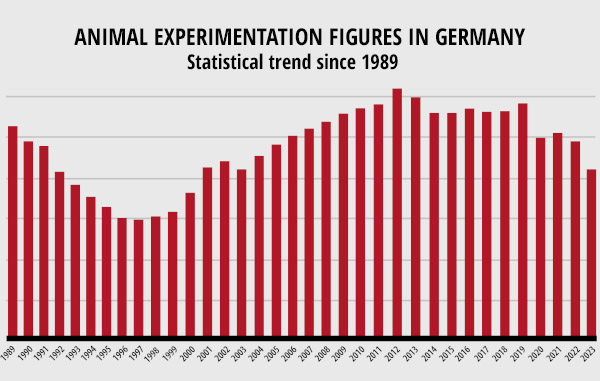Animal experimentation statistics 2023
- Press release
Positive trends, but too many animals are still suffering
The German Centre for the Protection of Laboratory Animals (Bf3R) has published the animal experimentation figures for 2023. Despite a slight decrease in the total number of animals recorded, the figure remains alarmingly high. For the association Doctors Against Animal Experiments (DAAE), the new data is yet another wake-up call: research in Germany must finally undergo a paradigm shift towards animal-free, human-relevant methods.
With a total of 3,501,693 animals recorded, including 1,456,562 animals used directly in experiments, there was a slight decrease compared to the previous year. In particular, the number of so-called surplus animals - animals that were bred but not used and killed for economic reasons - has fallen significantly by 22% to around 1.38 million. A reduction of 31% was already achieved in the previous year. Initial interpretations speak of optimised experimental planning - but for DAAE it is questionable how such an enormous reduction could be effectively achieved in such a short time. It would also raise the question of how seriously this problem was dealt with beforehand.
As in previous years, mice are the most frequently used animal species in experiments, with 1,062,632 animals (73%). Fish are the second most common animal species with 161,713 (11.1 %), followed by rats with 102,731. However, rabbits (67,524), birds (20,521), pigs (9,643), guinea pigs (7,863), dogs (2,550), monkeys (1,676), cats (544) and other animal species continue to be used. These figures refer to animals ‘used’ in animal experiments.
A major problem with the current statistics is the continuing lack of transparency. While animal protection organisations look at the total number of animals - including surplus animals and animals killed for organ removal - authorities prefer to emphasise the number of animals used in experiments. This gives the impression of a more significant decline than the overall figures suggest. In addition, animals that die during transport or in breeding farms, as well as most invertebrates, are still not recorded at all.
While animal suffering in experiments has decreased slightly, over 50,000 animals still underwent suffering of the category 'severe' in 2023. However, an analysis by DAAE shows that the suffering of animals is often downplayed and even very distressing experiments are categorised as 'moderate' or 'mild'. In addition, experiments for basic research continue to account for the largest part: 852,209 animals (58.5 %) were used in this field alone - an increase of 3 % compared to the previous year.
The number of non-human primates used in experiments has fallen from 2,267 (2022) to 1,676. However, the Bf3R uses the figures from 2018 for comparison. In this year, the number of 3,324 non-human primates used in animal experiments reached an unusual high. Taken for comparison, this results in an exaggerated decrease of 49% in the number of monkeys used. However, even this is not very meaningful, as the figures fluctuate enormously over the years in this area in particular.
The slow but steady spread of animal-free methods in regulatory research is encouraging, and of course also contributes to the reduction in the number of animal experiments. Technologies such as organ chips, cell cultures and computer-aided models are gaining in importance and offer promising so-called alternatives. Nevertheless, there is a lack of funding and clear objectives for the further development and use of these methods. A great deal of potential remains unused here.
"The current figures are a small step in the right direction, but nowhere near enough. It is time to finally see animal experiments as an obsolete model and prioritise innovative, ethical and scientifically superior methods instead," emphasises Dr Melanie Seiler, primatologist and CEO for Public Relations at DAAE.

Figure 1: The trend graph shows the number of animals used in experiments and those killed for scientific purposes.
